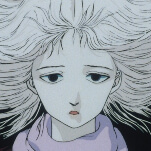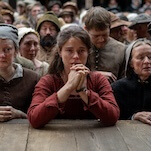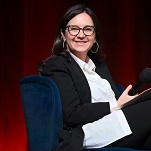Each week, Big Issues focuses on a newly released comic-book issue of significance. This week, it’s Team 7 #0. Written by Justin Jordan (The Strange Talent Of Luther Strode, Hack/Slash) and drawn by Jesús Merino (Superman, Justice Society Of America), it’s a Wildstorm revival that’s more playful and clever than most of the New 52 books and a move in the right direction for DC’s “Edge” line of titles.
A major problem of DC’s New 52 has been the resurgence of ’90s Marvel Comics creators like Scott Lobdell, Howard Mackie, and Rob Liefeld, people who made the Marvel universe an impenetrable tangle of clones, oversized guns, and other nonsense. Marvel filed for bankruptcy in 1996 and only after editor-in-chief Bob Harras was removed from power did the publisher begin to climb its way out of the depths to become the industry leader. Harras has since become EIC at DC Comics, bringing many of his old employees with him, specifically to the “Dark,” “Edge,” and “Young Justice” lines of the New 52. In May, Harras handed over writing duties on Deathstroke and Grifter, “Dark” titles both, to the controversial Rob Liefeld, who made a dramatic exit from DC last month in a Twitter-fueled wave of fury that has yet to fully subside. Liefeld attacked DC editorial for its lack of communication and for pushing his stories in directions he didn’t agree with, but editorial could do much worse than moving in the direction of Justin Jordan and Jesus Merino’s Team 7.
A revival of an old Wildstorm title featuring characters like Grifter and John Lynch, who are joined now by DC stalwarts like Dinah “Black Canary” Drake, Amanda Waller, and Slade “Deathstroke” Wilson, Team 7 jumps back five years to when superheroes first appeared in the new DC universe. The New 52 has needed a book that digs into the history of the line’s altered continuity, and hopefully Team 7’s flashback status means that major events of the untold five years will begin to come into focus. There isn’t much of that in this first issue, which is the obligatory “let’s get the team together” story, but Jordan does impressive work laying down the groundwork for this series as he establishes the characters and mission statement.
Put together by the ever-shady John Lynch, Team 7 is humanity’s defense against the emerging threat of metahumans, aliens, and supernatural creatures. It’s not necessarily the most original concept, but superhero comics aren’t the best place to look for bold new ideas. What Team 7 lacks in innovation it makes up for in finesse, with Jordan and Merino delivering a quickly paced, action-packed debut that still has a sense of humor and hope. The latter is the most impressive aspect of Jordan’s script, giving the story an optimistic tone in spite of all the people getting shot. As this week’s #0 issues of Grifter, Deathstroke, and Suicide Squad reveal (there’s that editorial hand at work), things don’t end well for Team 7, and building up a positive atmosphere will make the team’s collapse all the more powerful.
Jordan’s The Strange Talent Of Luther Strode showed his talent for using humor as a contrast to graphic violence. While Team 7 doesn’t have anyone getting his guts kicked out of his body, it still uses humor to balance the action. Not just jokes, either. Jordan’s characters are a clever bunch, but most of the book’s lightness comes from showing these people enjoying what they do. While recruiting new character James Bronson to the team after watching him climb a mountain, Dinah Drake asks him why he pushes himself so hard when he’s already at the top of his peers. His response: “Because I can be the best. What’s the point of doing anything less?” Bronson’s words could apply to Jordan’s script, and this first issue reads like DC finally understands the potential in these characters and in this new universe. It’s missing the doom and gloom that seem to have fallen over most of DC’s line, and at the end of the issue when Lynch says, “Let’s go save the world,” it almost seems like something this team can accomplish.
With a cast of 10 characters, Jordan has a lot of ground to cover in a short amount of time, but he manages to give each team member a moment in the spotlight, although some get more focus than others. Jordan wisely chooses to break most of the characters up into pairs: Dinah and future husband Kurt Lance, Slade Wilson and Alex Fairchild (fathers of The Ravagers’ Rose Wilson and Caitlin Fairchild), Amanda Waller and new character Dean Higgins. Giving these characters an established relationship with at least one other member strengthens the fiber of the team, and in the case of Dinah and Kurt, should infuse the book with some of the soap-opera romance that helps drive a superhero-team book forward.
The character work is unexpectedly strong on this title, and more importantly, it doesn’t come at the expense of action. Rather, action informs character, and watching how the different team members operate in a combat situation shows what roles they’ll play on the team: Dinah and Kurt flirt as they jump into battle (romantic leads); Slade and Alex are ruthless killers who will switch sides to pay debts (morally ambiguous powerhouses); Cole “Grifter” Cash chugs a bottle of whiskey after getting into a bar fight in Paris (charming outlaw); Amanda and Dean operate with black-ops-level efficiency (straight men). Now that most of the legwork is out of the way, it’s time to see how this group works together, and this issue ends with a badass team shot that turns up the excitement for the next installment.
After serving as Carlos Pacheco’s long-time inker, Jesús Merino’s artwork has taken on Pacheco’s detailed but distinctly superhero-ish style, an appropriate fit for Jordan’s dynamic, but not overly dark story. It would be interesting to see what a grittier artist like Michael Lark or Gabriel Hardman would bring to this title, and with the story’s human perspective on the superhero issue, the art could use a more realistic point of view. Perhaps down the line, when the team begins to fall apart and the book’s content gets a little more serious, a change in artist would be advisable. That said, Merino’s artwork is a big step up from the artwork on the pages of the Team 7 tie-in books. He has a thorough understanding of human anatomy and facial expressions, and he draws a cast of 10 characters who each have a unique appearance. There’s a remarkable amount of detail in the environments and costumes, and that specificity remains even when the action ramps up. Marino is a consistently strong draftsman but not the fastest, so hopefully the visuals on Team 7 won’t fall prey to the same artistic shuffling that has plagued many of the New 52 titles. If Marino falls behind, perhaps DC can have fill-ins by Jordan’s Luther Strode collaborator Tradd Moore, who has proven himself quite the talent when it comes to balancing character development with extreme action.
DC took a risk in picking a relative newcomer for Team 7, but Jordan’s first issue shows that grabbing talent from the expansive pool of skilled independent-comic creators is a smart idea. Most of Marvel’s current top writers have come from the world of creator-owned comics, proving that sometimes all it takes to revive a floundering property is a fresh set of eyes. With Liefeld’s departure, the solo titles of two Team 7 members have uncertain futures; if the publisher can’t put Jordan on either Deathstroke or Grifter, they should certainly ask for his input in finding a like-minded creator as those books become more deeply connected to Team 7. Amiable creators working together is a strategy that’s worked for Marvel as they realigned the Avengers, Spider-Man, and X-Men franchises in the past few years. Maybe rather than drawing inspiration from the Marvel of 1992, DC should be looking at their competitor’s current model.







































